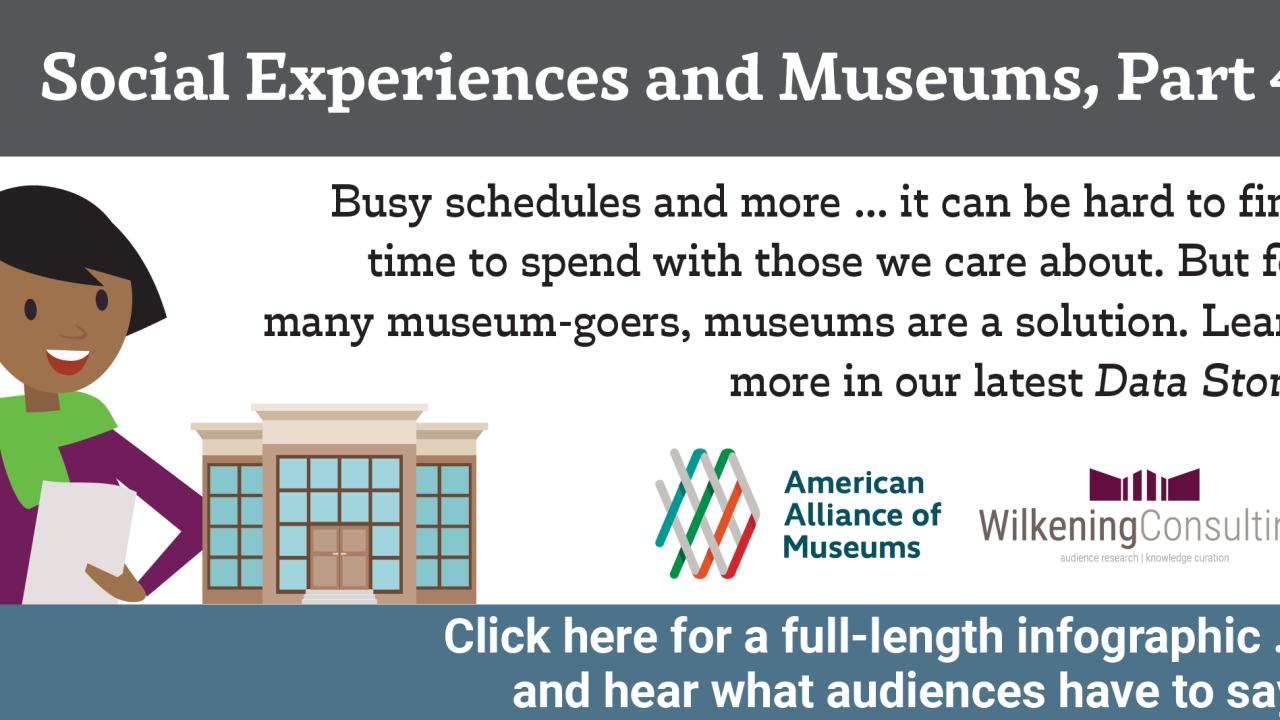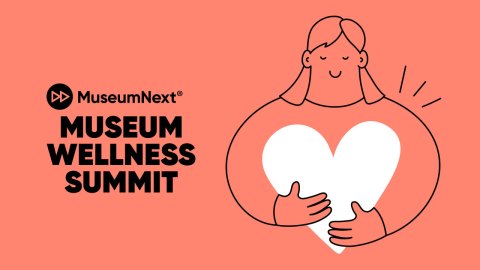
This visual Data Story is based on findings from the 2025 Annual Survey of Museum-Goers, a national survey of American museum visitors from AAM and Wilkening Consulting. Every year, the survey partners with individual museums to research their audiences and yield insights about their behaviors and preferences, both on an institutional and national level. (Learn more about the purpose and methodology of the survey here.) Interested in joining the 2026 edition on the themes of earned income and the meaning and value of museum experiences? Sign up by December 1 to unlock a special early bird rate!

Life can be really busy.
Even for the most avid museum-goers, other commitments and schedules get in the way of finding time to visit museums.
It can even make it hard to find time to connect with the people we care the most about.
As we mentioned in the first part of this series on social experiences and museums, one of the sentiments we were picking up was that family connection was becoming harder.
For this Data Story, we are focusing on the challenge part of this sentiment. Half of our sample of frequent museum-goers, chosen randomly, received this open-ended question:
We are interested in learning more about how easy or challenging it is to spend time with and connect with people you care about, including at museums.
Do you find it challenging to find time to connect with your family or friends?
If so, what’s making it tricky to find that time?Do you think museums are (or can be) places for connecting with those you care about? Why or why not?
We then hand-coded responses from a representative (but randomly chosen) sample of 8,000 respondents.
The question really is a two-parter, so let’s take a look at that first part: challenges.
The majority of written-in respondents indicated significant barriers to finding social connection time with loved ones. They fell into two main categories:
Time and Schedules
Respondents talked about time in two similar, but slightly different ways, often in the same comment.
They referred to the general hecticness of everyday life, with all of its obligations and responsibilities …
“Most of us are caught in the cultural trap of busyness…”
… and they also lamented how difficult it was to schedule time with everyone’s busy calendars. That is, no one had the same schedules, and thus the same blocks of free time, making planning extremely difficult.
“[We] have differing schedules for work, errands, and the must-dos every day. Plus, our existing lives are so busy that without planning specific actions and times, nothing would ever get added on…”
Other Barriers
A variety of other barriers came up as well, including:
Social isolation: living far from loved ones, having relatively few friends or family, and/or a sense of loneliness
“I live too far away from almost everyone. I wish there was a friendship or even dating program connecting people with common interests…”
Health issues: physical challenges (especially aging) as well as concerns around viruses and illness
“My mom is elderly with limited mobility and energy. Accessibility is huge, including … more places to rest once inside, places to sit and look at exhibits, places to sit out of the crowd.”
Cost concerns
“It’s challenging to find affordable outings for family and friends. Memberships make a huge difference.”
Convenience of social destinations: hours of operation, transportation, and parking, etc.
“Museums need to make it easy. Parking, strollers available on-site, food options, quick check-in, quick placement of exhibits so that kids can get started right away. Every minute we’re not actually in the exhibits is a burden. But the time spent is so worthwhile for all involved.”
Obviously, museums cannot solve the time challenges of modern society (though we can often be a respite from it!). But the other barriers mentioned should look quite familiar, as they are recurring themes we have already seen in this series on social experiences; some have also been the focus of Data Stories in previous years.
Despite all of those busy schedules and a few barriers, there is some very good news here as well.
The overwhelming consensus among respondents is that yes, museums are fantastic places for social connection.
(Only 6% of respondents said “nope,” and most of them said it was because they preferred to visit museums on their own, so even that isn’t really a negative.)
Why museums?
Lots of reasons, including that museums are places of:
Shared interests and shared experiences
“My mom took me every weekend to art classes [at the museum] and now we’ve visited as adults… It is something we do together that has bonded us through time. I love experiencing new art with her!”
Learning, exploration, and curiosity
“My friends and family also enjoy learning, so it’s fantastic to attend exhibits, classes, and presentations together — it allows the opportunity to discuss what you are learning, and explore topics with the assistance of staff…”
Inspires meaningful conversations that help us learn more about each other
“I think museums are a great place to connect with people you care about! Exploring and discussing new ideas and knowledge is a great bonding activity.”
And are places of inter-generational connection
“I love museums that have interactive exhibits for the whole family (from young children to elders), with spaces to rest and then continue.”
Again, sound familiar? As we saw in the second part of this series on social experiences, these traits are among those most desired by the public for encouraging stronger connections with their loved ones.
What makes museums stand out from most other places, however, were two of these things.
First, the quality of the conversations that our experiences catalyze. Many places can inspire conversation, but museums excel at meaningful conversations through the depth of content we share. That sets museums apart in a way that matters.
Second, that idea of learning, exploration, and curiosity. When people consider public places for social connection in general, this doesn’t really come up. But it sure did when thinking about museums specifically! Honestly, that’s not surprising. People have long thought of museums as places that naturally excel at these things, no matter how often they visit.⁵
For people who visit museums regularly, these attributes make museums even more compelling as destinations for meaningful family time. That’s because the majority of them deliberately seek out learning activities during their leisure time.
But for more sporadic visitors, the idea of “exploration” would likely be more attractive, as only a third of these potential visitors consider “learning” a desirable leisure time activity. (Though if they happen to learn while having fun, they are pretty pleased with that outcome.)
That means how we talk about museums as places of “learning” may require some calibration depending on who we are talking with.
Overall, however, the public largely agrees that museums are great places for engendering social connections with those we care about. And that’s something that is harder to find in our busy, distraction-filled lives. Bottom line, sharing how a museum visit can be a deliberate choice to choose connection with loved ones is going to resonate well with most potential visitors.
“I make time to be with family and friends because I feel happier when I’m with them. Museums are a great third place; they tend to be beautiful and enriching. They also tend to be inviting and inclusive spaces for people of all ages. Whenever out of town family is visiting, I usually include visiting a museum; visiting a museum together gives us a chance to connect in new and meaningful ways. I really value museums and appreciate their place in our community.”
“Museums can absolutely be places for connecting!! They inspire conversations and also show me how people thought and created at different eras of human history. I feel more connected to humanity and loved ones when I get to experience the museum with them.”
Annual Survey of Museum-Goers Data Stories are created by Wilkening Consulting on behalf of the American Alliance of Museums. Sources include:
- 2025 Annual Survey of Museum-Goers, n = 98,904; 202 museums participating
- 2025 Broader Population Sampling, n = 2,079
- 2017 – 2024 Annual Surveys of Museum-Goers
Data Stories share research about both frequent museum-goers (typically visit multiple museums each year) and the broader population (including casual, sporadic, and non-visitors to museums). See the Purpose and Methodology (Update) Data Story from September 11, 2025 for more information on methodology.
More Data Stories can be found at https://wilkeningconsulting.com/data-stories/.
© 2025 Wilkening Consulting, LLC








